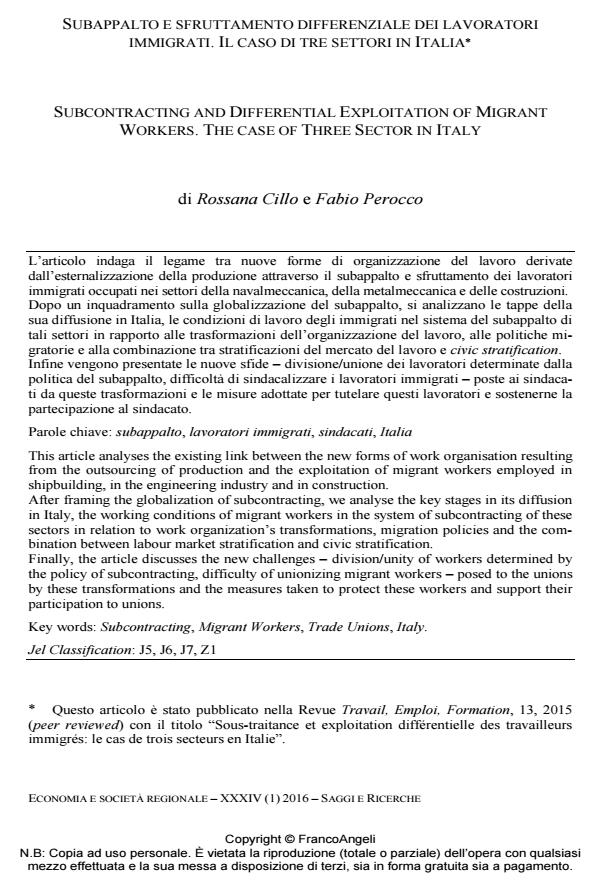Subcontracting and differential exploitation of migrant workers. the case of three sector in Italy
Journal title ECONOMIA E SOCIETÀ REGIONALE
Author/s Rossana Cillo, Fabio Perocco
Publishing Year 2016 Issue 2016/1
Language Italian Pages 23 P. 101-123 File size 297 KB
DOI 10.3280/ES2016-001008
DOI is like a bar code for intellectual property: to have more infomation
click here
Below, you can see the article first page
If you want to buy this article in PDF format, you can do it, following the instructions to buy download credits

FrancoAngeli is member of Publishers International Linking Association, Inc (PILA), a not-for-profit association which run the CrossRef service enabling links to and from online scholarly content.
This article analyses the existing link between the new forms of work organisation resulting from the outsourcing of production and the exploitation of migrant workers employed in shipbuilding, in the engineering industry and in construction. After framing the globalization of subcontracting, we analyse the key stages in its diffusion in Italy, the working conditions of migrant workers in the system of subcontracting of these sectors in relation to work organization’s transformations, migration policies and the combination between labour market stratification and civic stratification. Finally, the article discusses the new challenges - division/unity of workers determined by the policy of subcontracting, difficulty of unionizing migrant workers - posed to the unions by these transformations and the measures taken to protect these workers and support their participation to unions.
Keywords: Subcontracting, Migrant Workers, Trade Unions, Italy.
Jel codes: J5, J6, J7, Z1
- Precarizzazione strutturale del lavoro e precarizzazione globale delle migrazioni. L'esempio dei lavoratori in distacco intracomunitario Fabio Perocco, in ECONOMIA E SOCIETÀ REGIONALE 3/2018 pp.132
DOI: 10.3280/ES2018-003011 - A Historical Analysis of Left-Wing Trade Union Positions Regarding Bangladeshi Workers in Monfalcone (Italy) and Bosnian Workers in Slovenia Loredana Panariti, in Two Homelands /2024
DOI: 10.3986/2024.1.08 - Stratificazione, nocività e lavoro immigrato. il caso del distretto conciario della Valle del Chiampo Davide Marchi, in ECONOMIA E SOCIETÀ REGIONALE 1/2024 pp.61
DOI: 10.3280/ES2024-001005
Rossana Cillo, Fabio Perocco, Subappalto e sfruttamento differenziale dei lavoratori immigrati. il caso di tre settori in Italia in "ECONOMIA E SOCIETÀ REGIONALE " 1/2016, pp 101-123, DOI: 10.3280/ES2016-001008